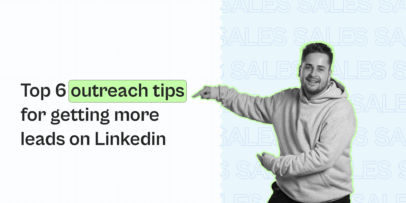9 Modern Sales Closing Techniques to Overachieve Your Sales Quota

In today’s competitive business landscape, meeting sales quotas is no longer enough. Sales teams must go above and beyond to achieve exceptional results. To succeed, they need best sales closing techniques that align with the evolving marketplace.
In this article, we will explore ten cutting-edge techniques designed to help sales reps surpass their quotas and drive revenue growth. These strategies leverage technology, psychology, and persuasive communication to secure customer commitments. By incorporating these techniques into your sales process, you’ll gain a competitive edge and elevate your closing abilities.

1. The Assumptive Close
Definition and Explanation
So here’s the deal, the Assumptive Close is one of the closing sales techniques that work like a charm. It’s all about knowing that your prospect has already made up their mind to buy. You’re basically steering the conversation towards sealing the deal and nudging the prospect to make the purchase. The secret sauce? Confidence and being able to pick up on the buyer’s cues.
But hey, don’t be too pushy! The Assumptive Close is more like a gentle nudge than a hard sell. Instead of dragging things out, you smoothly guide the discussion toward the next steps of actually getting the product or service. It’s all about smoothly moving things forward and wrapping up the sales process.
How to Use It Effectively
- Read the prospect. Pay attention to their body language and reactions to gauge their interest and readiness to buy.
- Assume the sale. Approach the conversation with the belief that the prospect is already on board. Use language that assumes their decision to purchase.
- Emphasize implementation. Shift the discussion towards how the product or service will be used in their specific situation.
- Offer assumptive choices. Present options that assume their commitment to the purchase, guiding them towards actively participating in the buying process.
- Maintain a relaxed tone. Be confident yet respectful, avoiding pushiness or desperation.
- Handle objections calmly. Address concerns positively, highlighting the value and benefits they’ll receive.
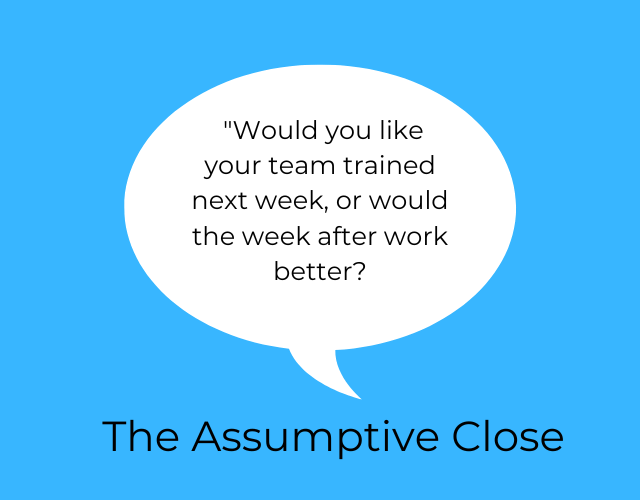
Examples
Using phrases like “When should we schedule your onboarding?” or “What delivery date suits you best?” can smoothly lead the conversation towards a closed deal.
Imagine you’re a car salesperson. Instead of asking your customer, “Would you like to buy this car?” you might say, “Would you prefer the red model or the blue one?”
Or, if you’re selling software, you might ask, “Would you like your team trained next week, or would the week after work better?” By framing your questions this way, you are assuming the sale is happening, and you’re just working out the details. This technique can reduce resistance and create a smoother transition from prospect to customer.
These phrases implicitly assume that the prospect is ready to make a purchase and is deciding on the specifics. It’s about making the closing part of the conversation, not a jarring transition or forceful push.

2. The Summary Close
Definition and Explanation
The Summary Close is a sales closing technique that’s all about reminding your potential customer of the awesome things your product or service can do for them. Basically, you repeat the key benefits and values that they’ve shown interest in during your conversation. This helps them see that buying what you’re offering is the smart choice.
To pull off the Summary Close, you need to be a good listener and remember what’s important to your prospect. It’s not just about listing off the features and perks of your product. It’s about showing how those features and perks can specifically meet the individual needs and desires of your potential customer.
How to Use It Effectively
So, here’s how you can rock the Summary Close:
- Pay attention and take notes. During your conversation with the prospect, listen carefully to their needs, desires, and the benefits they’re interested in. Take notes if it helps you remember the key points.
- Highlight the key benefits. When you’re ready to close the deal, summarize the main benefits and values that your product or service can offer. Focus on what matters most to the prospect and what they’ve expressed interest in.
- Personalize the benefits. Make it personal! Connect the benefits to the prospect’s unique situation and needs. Show them how your product or service can solve their specific problems or fulfill their desires.
- Use their own words. If the prospect mentioned specific benefits they liked, try to use their own words when summarizing. This shows that you were really listening and understanding their needs.
- Reinforce the decision. Emphasize that choosing your product or service is the right decision. Remind them of the positive outcomes they can expect and how it aligns with their goals.
- Be confident and enthusiastic. When delivering the summary, exude confidence and enthusiasm. Show genuine excitement about the value your product or service brings. This can help sway the prospect towards making the purchase.
- Address any concerns. If the prospect has expressed concerns or objections, address them before the summary. Reassure them and provide solutions to their worries. This helps build trust and confidence in your offering.
Remember, the key is to personalize the benefits and make the prospect feel like you understand their unique needs. By doing so, you’ll increase their confidence in your product or service and boost your chances of closing the deal successfully.
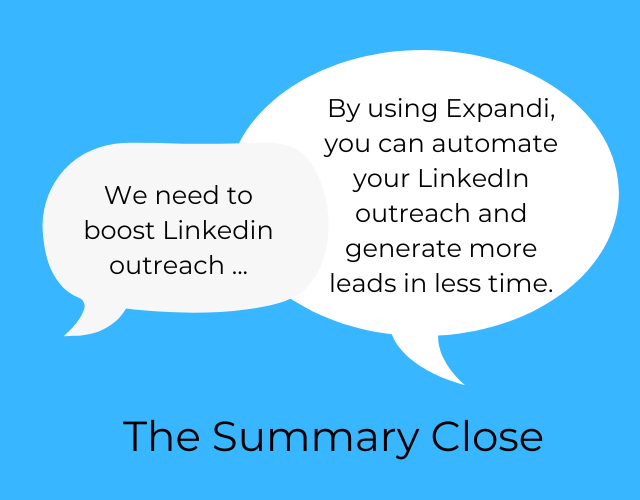
Examples
Software Solution.
“Based on our conversation, I understand that you’re looking for a way to maximize your LinkedIn outreach and generate more leads for your B2B business. With Expandi.io, you’ll have a powerful automation tool at your fingertips. It allows you to automate personalized connection requests, send targeted messages, and engage with your network at scale. By using Expandi.io, you’ll be able to save hours of manual work, increase your outreach efficiency, and reach a larger audience of potential clients.”
Marketing Services.
“From our discussions, I gathered that your B2B company needs a strategic marketing partner who can create compelling content to engage your target audience, optimize your website for search engines to boost organic traffic, and run targeted campaigns across channels that align with your industry. Our dedicated marketing team will work closely with you to achieve those goals, increasing brand visibility, generating quality leads, and driving conversions tailored to your unique business needs.”
HR Consulting Services.
“From our conversation, it’s clear that your organization is facing difficulties in talent acquisition, employee retention, and performance management. Our HR consulting services provide expertise in these areas, offering solutions such as recruitment strategies, training programs, and performance evaluation frameworks. Given the potential benefits to your organization, are you ready to engage our consulting services?”
By aligning your summary with their needs, you make a compelling case for the purchase.
3. The Take Away Close
Definition and Explanation
The Take Away Close is an effective sales closing technique that taps into people’s fear of missing out. Instead of pressuring the prospect to buy, you create a sense of scarcity by suggesting that the offer may not be available if they wait too long. It’s like saying, “Hey, if you don’t act now, you might lose out on this great opportunity!”
This technique works because humans have a natural tendency to want what they can’t have. When faced with the possibility of missing out on something valuable, people are motivated to take action and make a decision. It’s all about creating a sense of urgency and pushing the prospect from simply considering the purchase to actually committing to it.
How to Use It Effectively
- Build value. Before employing the Take Away Close, ensure that you have effectively communicated the value of your offer. Highlight the benefits, advantages, and unique features that make it attractive to the prospect.
- Create desire. Generate enthusiasm and desire for your offer. Help the prospect envision how their life or business could improve by taking advantage of what you’re offering.
- Introduce scarcity. Once you’ve established the value and desire, introduce the notion of scarcity. Mention that the offer may not be available indefinitely or that there are limited quantities or spots available.
- Emphasize the consequences of waiting. Explain the potential negative outcomes or missed opportunities if the prospect delays their decision. Illustrate how they might regret not taking action and emphasize the benefits of acting now.
- Offer an incentive. To make the Take Away Close more compelling, consider offering a special bonus or discount that is time-limited. This further motivates the prospect to act quickly and seize the opportunity.
- Soften the Take Away. While you’re creating a sense of urgency, it’s important to strike a balance and not come across as too pushy or manipulative. Use a friendly and casual tone, and let the prospect know that you genuinely want to help them make the right decision.
- Gauge their response. Observe the prospect’s reaction and response to the Take Away Close. Are they showing signs of increased interest or urgency? Are they asking more questions or expressing a desire to move forward? Assess their level of commitment and readiness to make a decision.
- Be prepared to negotiate. In some cases, the Take Away Close may lead to objections or hesitations from the prospect. Be ready to address their concerns, answer questions, and possibly offer alternative solutions to keep the conversation going.
Remember, the goal of Take Away Close is to create a sense of urgency and motivate the prospect to take action. By using scarcity and emphasizing the potential consequences of waiting, you can encourage them to make a commitment and move forward with the purchase.

Examples
Here are a few examples of how you can apply the Take Away Close technique:
Deadline-driven offer.
Consider a software company selling annual subscriptions to their service. A Take Away Close might be,
“I should let you know, our annual subscription is increasing in price next month. If you decide to sign up today, you’ll lock in the current rate for a full year.”
Limited time offer.
“Hey, I just wanted to let you know that this special discount is only available for the next 24 hours. After that, it’s gone. So if you want to take advantage of this great deal, you’ll need to act fast.”
Exclusive access.
“We have a select group of clients who benefit from our premium lead generation services. However, we’re reaching our client capacity. If you want to be part of this exclusive group, let’s connect soon before all the spots are filled.”
Competitive advantage.
“Our lead generation strategies give our clients a significant edge in their industry. But here’s the thing – we can’t work with everyone. We’re selective about the businesses we partner with, so if you want to gain a competitive advantage, let’s discuss your goals before we reach our client capacity.”
Early bird benefits.
“Our new course is launching next month, and if you enroll early, you’ll get access to some incredible bonuses. However, once the course starts, these bonuses won’t be available anymore. So if you want to get the most value out of your investment, it’s best to secure your spot now.”
4. The Something for Nothing Close
Definition and Explanation
The Something for Nothing Close is all about giving your prospects a pleasant surprise. You offer them an extra benefit or bonus that they didn’t see coming. It’s like saying, “Hey, guess what? I’ve got something extra special for you!”
This technique works because people love getting something for nothing. When you go above and beyond their expectations and give them an unexpected bonus, it creates a sense of goodwill and makes them feel valued. And when people feel like they’re getting more value, they’re more likely to seal the deal and make the purchase.
The best part? It’s a simple yet effective technique that can leave a lasting positive impression on your prospects. Who doesn’t love a little something extra for free?
How to Use It Effectively
To use the Something for Nothing Close technique effectively, follow these steps:
- Understand your prospects. Get to know your prospects’ preferences, needs, and pain points. This will help you identify what type of additional benefit or bonus would be most valuable to them.
- Identify the surprise. Determine what extra value you can offer that goes beyond what the prospect is expecting. It could be a freebie, an additional service, a discount, or any other enticing bonus that complements your main offer, a free consultation, an extended warranty, a gift, or additional features.
- Highlight the surprise. During your sales pitch or conversation, emphasize the main benefits of your offer first. Then, at the right moment, introduce the surprise by saying something like, “And as a special bonus, I’ve got something extra for you!”
- Emphasize the value. Clearly communicate the value of the surprise and how it enhances the overall offer. Explain how it addresses a specific need or provides an additional advantage to the prospect.
- Create excitement. Build anticipation and excitement around the surprise. Use enthusiastic language and convey genuine enthusiasm about being able to offer this unexpected bonus.
- Reinforce generosity. Emphasize that this additional benefit is a gesture of goodwill and that you genuinely want to provide extra value to the prospect. Make them feel special and appreciated.
- Close the deal. Once you’ve introduced the surprise, leverage the excitement and positive sentiment to close the sale. Emphasize how this additional benefit enhances the value proposition and makes the offer even more compelling.
- Deliver on your promise. Follow through on your commitment and ensure that the surprise is delivered as promised. This will solidify the positive experience and reinforce the prospect’s trust in your brand.
The key to using this technique effectively is ensuring the added bonus offers real value to the prospect while also being cost-effective for your business.
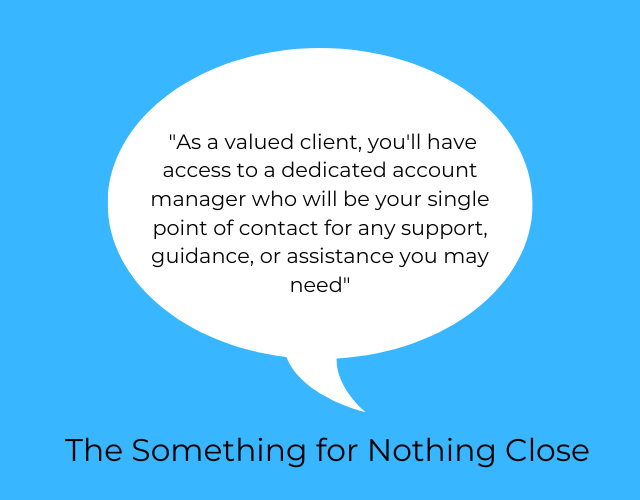
Examples
Extended trial period:
“Normally, our trial period is 14 days, but as a special offer for you, I can extend it to 30 days. This will give you more time to fully explore and experience the benefits of our software without any obligations.”
Free Consultation:
“As a thank you for considering our services, we’d like to offer you a complimentary consultation session with our experts. This will provide you with valuable insights and customized recommendations to address your specific business challenges.”
Bonus training materials:
“When you sign up for our B2B marketing course, we’ll include bonus training materials, such as e-books and video tutorials, absolutely free. These resources will further enhance your learning experience and help you implement effective strategies.”
Dedicated account manager:
“As a valued client, you’ll have access to a dedicated account manager who will be your single point of contact for any support, guidance, or assistance you may need. This personalized service comes at no extra cost and ensures that your experience with us is exceptional.”
Exclusive industry insights:
“In addition to our main service, we’ll provide you with exclusive industry reports, market trends analysis, and whitepapers relevant to your business. These insights will give you a competitive edge and keep you updated on the latest developments in your industry.”
5. The Sharp Angle Close
Definition and Explanation
The Sharp Angle Close is a sales closing technique move that comes into play when a prospect asks for something extra during the negotiation. Here’s how it goes: the salesperson agrees to the request, but there’s a catch – the prospect has to commit to the purchase right then and there.
It’s like saying, “Sure, I can give you that extra discount or concession, but only if you’re ready to seal the deal right now!”
This technique works because it creates a sense of urgency and encourages the prospect to make a decision on the spot. By offering the additional benefit but attaching a condition to it, you motivate the prospect to act quickly and avoid losing out on the extra perk.
The Sharp Angle Close is a clever tactic that allows the salesperson to meet the prospect’s request while also securing the commitment. It keeps the negotiation moving forward and increases the chances of closing the sale swiftly.
How to Use It Effectively
- Understand the prospect’s request. Listen carefully to the prospect’s additional concession or benefit they are seeking during the negotiation. Make sure you fully comprehend their needs and what they are asking for.
- Evaluate the request. Consider whether the requested concession or benefit is reasonable and aligns with your sales objectives. Assess its potential impact on the deal and whether it’s something you can offer without compromising your bottom line.
- Agree to the request conditionally. Once you’ve evaluated the request, respond positively by agreeing to provide the additional concession or benefit. However, make it clear that this can only happen if the prospect commits to the purchase immediately.
- Create urgency. Emphasize the time-sensitive nature of the offer. Explain that the additional benefit is contingent on their commitment in that moment. Highlight the value they would receive by making the decision right away.
- Reinforce the value proposition. Remind the prospect of the main benefits and value they will receive from your product or service. Reinforce how the additional concession or benefit enhances the overall deal and provides them with even more value.
- Seek confirmation. Ask for a clear commitment from the prospect. Encourage them to confirm their decision and take advantage of the additional concession or benefit by closing the deal on the spot.
- Handle objections. Be prepared for any objections the prospect may raise. Address their concerns and reiterate the unique value proposition of your offer. Emphasize that the additional concession or benefit is a limited-time opportunity.
- Secure the commitment. Once the prospect agrees to the conditions and commits to the purchase, ensure all necessary steps are taken to finalize the deal promptly. Provide any required documentation or assistance to facilitate a smooth transition.

Examples
Additional discount for immediate commitment:
“I understand you’re looking for a better price. Here’s what I can do: if you commit to the purchase right now, I can offer you an additional 10% discount on top of our current offer. This special discount is exclusively available for immediate decision-makers like you.”
Extra service or feature for instant commitment:
“I see that you’re interested in our software solution. If you decide to move forward today, I can include an additional module at no extra cost. This module will provide enhanced functionality and save you thousands of dollars in the long run. It’s a limited-time offer only for those who make a commitment right away.”
Expedited implementation for on-the-spot commitment:
“If you give us the green light today, we can prioritize your implementation and have our team start working on it immediately. This means you’ll be up and running with our solution much faster, gaining a competitive advantage in the market.”
Extended trial period for immediate decision:
“I understand you’d like more time to evaluate our product. Here’s what I can offer: if you make a commitment today, I can extend your trial period from 14 days to 30 days. This will give you ample time to thoroughly test our solution and ensure it meets all your requirements.”
Access to exclusive resources for instant commitment:
“As a special bonus for clients who decide now, I can provide you with exclusive access to our premium resource library. This library contains in-depth guides, industry reports, and case studies that will assist your team in achieving better results and staying ahead of the competition.”
6. The Question Close
Definition and Explanation
The “Question Close” is a technique that helps you close deals by asking the right questions. Instead of just telling your prospect about the benefits of your product or service, you guide them to realize the value themselves. It’s like letting them convince themselves of how great your offering is.
With the Question Close, you ask questions that lead to positive responses and gradually build up to a resounding “yes” when you eventually ask for the sale. These questions encourage the prospect to express their thoughts about what you’re offering, and in the process, they often persuade themselves that making the purchase is a smart move.
How to Use It Effectively
- Understand your prospect. Before using the Question Close, make sure you have a good understanding of your prospect’s needs, desires, and pain points. This will help you tailor your questions to resonate with them.
- Ask open-ended questions. Instead of asking closed-ended questions that can be answered with a simple “yes” or “no,” ask open-ended questions that encourage your prospect to provide detailed responses. This allows them to explore their thoughts and express the value they see in your offering.
- Focus on benefits. Craft your questions in a way that highlights the benefits and outcomes your product or service can provide. Help the prospect envision the positive impact it can have on their life or business.
- Build momentum. Begin with easy questions that elicit positive responses. Gradually escalate to more specific questions that reinforce the value proposition. This creates a sense of momentum and increases the prospect’s confidence in their decision.
- Listen actively. Pay close attention to your prospect’s answers and actively listen to their concerns, preferences, and objections. This will help you address any potential roadblocks and adapt your approach accordingly.
- Summarize and reiterate. After a series of positive responses, summarize the benefits and value your prospect has acknowledged. This reaffirms their belief in the product or service.
- Ask for the sale. Once you’ve built a strong case, confidently ask for the sale. By this point, your prospect should be convinced of the value and more likely to respond positively.
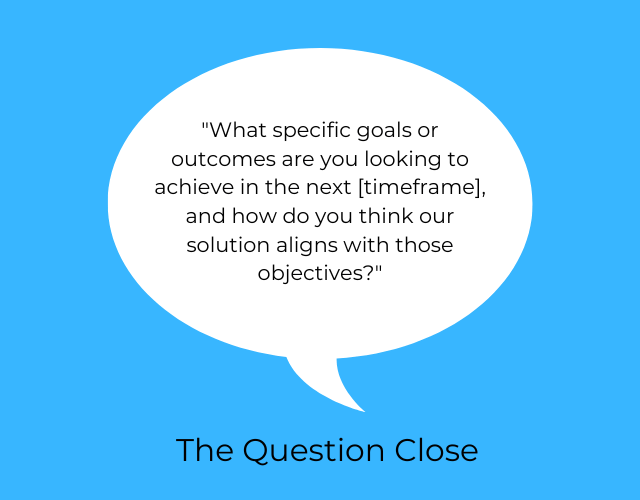
Examples
Some examples of the types of questions you might use in a Question Close include:
- Open-ended question about their current challenge:
“What are the main challenges your business is facing in [specific area]?”
- Benefit-focused question:
“How do you think addressing these challenges would impact your operational efficiency and cost savings?”
- Confirmation question about the potential value:
“Based on what we’ve discussed, it seems like our solution could greatly improve your [specific process]. Can you see how this would streamline your operations and enhance productivity?”
- Inquiring about their goals and objectives:
“What specific goals or outcomes are you looking to achieve in the next [timeframe], and how do you think our solution aligns with those objectives?”
- Problem identification question:
“In your current setup, what difficulties do you encounter when it comes to [specific problem]?”
- Follow-up question to gauge their interest:
“From what we’ve discussed so far, does it seem like our solution addresses the pain points you’ve mentioned?”
- Summarizing the benefits and value:
“Just to recap, our solution can help you overcome [specific challenges], increase efficiency by [X%], and drive significant cost savings. Can you see how this would positively impact your bottom line?”
- Asking for the sale:
“Given the benefits and value we’ve explored together, would you be ready to move forward and take advantage of our solution?”
In each case, the aim is to get your prospect talking and thinking about why they should buy from you. By the time you ask for the sale, they’ve already given you multiple affirmative responses.
7. The Analytics Close
Definition and Explanation
The Analytics Close is all about using data and analytical evidence to convince people about the awesomeness of your product or service. This technique works especially well for folks who love data and want solid facts before making a decision.
In an Analytics Close, the salesperson brings out the big guns – data, case studies, testimonials, and anything else that proves the value of what they’re selling. They’ll throw in stats showing how much money or time the product can save, how it boosts productivity and revenue, or how it has already worked wonders for other clients. It’s like saying, “Hey, look at all this proof that our thingamajig is the real deal!”
So, if you’re into crunching numbers and making informed choices, the Analytics Close might just be your cup of tea. It’s all about backing up claims with hard evidence and giving you the confidence to say, “Yep, this product rocks!”
How to Use It Effectively
- Know your audience. Understand who you’re selling to and determine if they’re the type of people who value data and analytical evidence. This approach works best with prospects who appreciate logical reasoning and facts to support their decision-making.
- Gather compelling data. Collect relevant data, case studies, testimonials, or any form of analytical evidence that demonstrates the value of your product or service. Look for statistics that highlight cost savings, time efficiency, productivity gains, revenue increases, or successful outcomes for previous clients.
- Customize your approach. Tailor your analytics close to align with the specific needs and interests of your prospects. Highlight data points that resonate with their pain points, challenges, or goals. Show them how your product or service addresses their unique needs and provides tangible benefits.
- Present data in a clear and engaging manner. Make sure your data is easy to understand and visually appealing. Use charts, graphs, and visual aids to present information effectively. Break down complex data into simple, digestible insights that clearly convey the value proposition of your offering.
- Tell a story with your data. Don’t just throw numbers at your prospects; create a compelling narrative around your data. Explain the context, share success stories, and illustrate how your product or service has made a positive impact on real businesses or individuals. This helps to create an emotional connection and strengthens the persuasive power of your analytics close.
- Address objections preemptively. Anticipate potential objections or doubts that prospects might have and proactively address them using your data. Show how your product or service overcomes common challenges or provides superior results compared to alternatives. Be prepared to explain any limitations or potential risks associated with your offering, but emphasize the overall value it provides.
- Follow up and reinforce. After presenting your analytics close, follow up with additional supporting materials or data if needed. Provide ongoing support and answer any questions or concerns that arise. Continually reinforce the value proposition of your product or service using data-driven insights throughout the sales process.
By effectively using Analytics Close, you can leverage the power of data and analytical evidence to build trust, make a compelling case, and ultimately increase the likelihood of closing the sale.
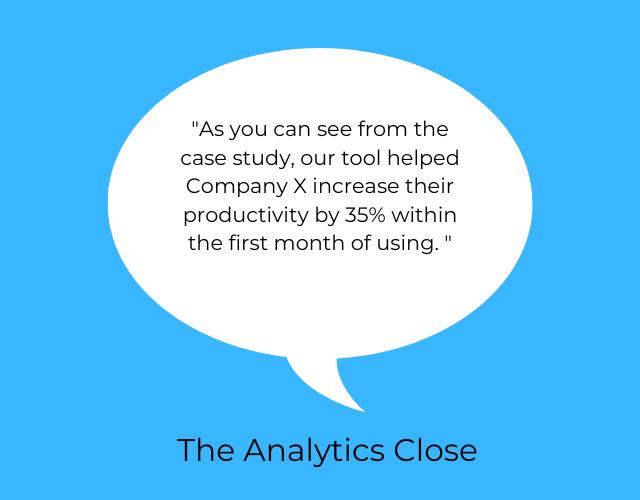
Examples
Cost Savings Analysis.
Suppose you’re selling a software solution that streamlines inventory management for businesses. In your Analytics Close, you can present data showing how your software has helped previous clients reduce inventory holding costs by an average of 20%. You can further break down the savings based on factors like reduced stockouts, minimized overstocking, and improved forecasting accuracy.
Productivity Improvement.
Let’s say you offer a project management tool. In your Analytics Close, you can showcase data indicating that companies using your tool have experienced a 35% increase in project completion rates. You can provide case studies demonstrating how the tool helps teams collaborate more efficiently, track progress, and meet deadlines, leading to improved overall productivity.
You might say, “As you can see from this case study, our software helped Company X increase their productivity by 35% within the first month of implementation. They’ve also reported a 50% reduction in errors. Can you imagine what such improvements could mean for your bottom line?”
Revenue Growth.
If you provide a marketing automation platform, you can leverage the Analytics Close to illustrate how your tool has driven revenue growth for other businesses. Present data showing that companies using your platform have seen a 40% increase in lead conversion rates and a 25% increase in customer retention. Use real-life success stories to demonstrate how your platform has helped businesses attract more leads, nurture them effectively, and closing deals.
Time Savings.
Suppose you offer a cloud-based HR management system. In your Analytics Close, highlight data indicating that companies using your system have saved an average of 15 hours per week on HR administrative tasks. Provide examples of specific tasks that your system automates or simplifies, such as employee onboarding, payroll processing, and leave management. Emphasize the time and resource efficiencies gained by using your solution.
Compliance and Risk Mitigation.
If you provide a cybersecurity solution, use the Analytics Close to demonstrate how your product helps businesses mitigate risks and ensure compliance. Present data on the average reduction in security breaches or instances of data loss experienced by your clients. Share industry benchmarks and regulations, highlighting how your solution aligns with and surpasses security standards, giving businesses peace of mind.
8. The Soft Close
Definition and Explanation
The Soft Close is all about gently guiding the prospect towards making a decision without making them feel like they’re being shoved into it. It’s like a subtle nudge in the right direction, rather than a forceful push. Instead of directly asking for the sale, this technique involves suggesting an action step that moves the prospect closer to making the purchase.
With the Soft Close, you’re aiming to create a comfortable and non-threatening environment where the prospect feels empowered to make a decision at their own pace. It’s like saying, “Hey, why not take a step forward and see where it leads?”
Rather than pressuring the prospect into an immediate purchase, you might suggest a trial period, offer a sample, or propose a consultation to explore their needs further. The idea is to create a low-pressure situation where the prospect can evaluate your product or service without feeling obligated to buy right away.
By using the Soft Close, you’re aiming to build trust, establish rapport, and gently guide the prospect towards a positive buying decision without resorting to aggressive sales tactics. It’s all about making the journey towards the sale feel natural and comfortable for both parties involved.
How to Use It Effectively
- Build rapport and understanding. Take the time to establish a connection with the prospect. Understand their needs, challenges, and goals. Show genuine interest in their situation and demonstrate that you’re there to help them find the right solution.
- Provide value and solutions. Throughout your interaction, focus on demonstrating the value of your product or service. Show how it can address the prospect’s pain points and help them achieve their desired outcomes. Provide relevant examples, case studies, or testimonials that highlight successful results.
- Listen actively. Pay close attention to the prospect’s feedback and concerns. Listen actively and address any objections or hesitations they may have. This shows that you value their input and are willing to address their needs.
- Suggest the next step. Instead of directly asking for the sale, propose a small action that moves the prospect closer to making a decision. It could be offering a product demonstration, providing a trial period, or scheduling a follow-up call to discuss specific details. The key is to present it as an opportunity for them to explore further and make an informed decision.
- Emphasize benefits and outcomes. Highlight the benefits the prospect can expect from taking the suggested action step. Paint a vivid picture of how their situation can improve, and how your product or service can help them achieve their goals. This helps them envision the positive results they can experience.
- Be patient and follow up. Respect the prospect’s decision-making process and be patient. Give them time to consider the suggested action step and evaluate their options. After the proposed step, follow up with the prospect to address any questions, provide additional information, or offer further assistance. Maintain a helpful and supportive approach throughout the follow-up process.
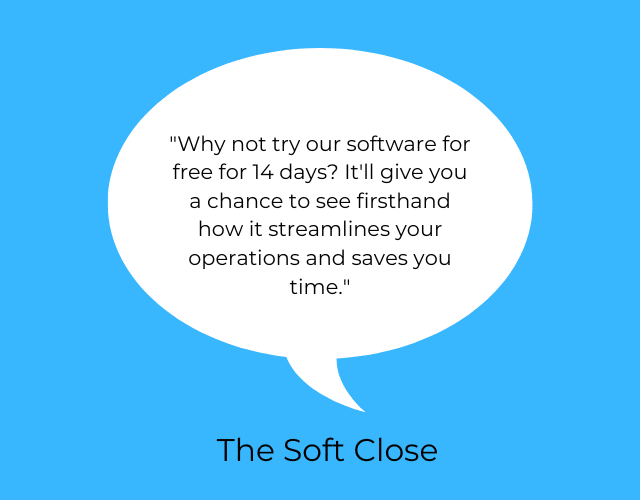
Examples
Free Trial or Demo.
If you’re selling a software solution, instead of pushing for an immediate purchase, offer a free trial or demo.
You can say something like, “Why not try our software for free for 14 days? It’ll give you a chance to see firsthand how it streamlines your operations and saves you time.”
Consultation or Needs Assessment.
If you provide consulting services or customized solutions, suggest a consultation or needs assessment as the next step.
For example, you could say, “Let’s set up a meeting to discuss your specific requirements and challenges in more detail. This way, we can tailor our services to best meet your needs.”
Case Study or Success Story.
Share a relevant case study or success story that showcases how your product or service has helped other businesses.
Then, gently suggest that the prospect can explore the potential benefits by saying, “Here’s an example of how we helped a similar company achieve impressive results. Would you like to learn more about how we can do the same for you?”
Resource or Educational Material.
Provide valuable resources or educational material related to the prospect’s industry or challenges. This can be in the form of whitepapers, guides, or industry reports.
Say something like, “We have an informative industry report that highlights key trends and best practices. Would you like us to send it to you? It can help you make more informed decisions for your business.”
Referral or Introduction.
If the prospect expresses interest but is not quite ready to commit, suggest making an introduction to one of your existing clients who had a similar challenge.
You can say, “I can connect you with one of our clients who faced a similar situation. They can share their experience and how our solution benefited them. Would you like me to arrange that introduction?”
9. The Puppy Dog Close
Definition and Explanation
What is it and how does it work?
So, imagine this: you go to a pet store with your family and come across the most adorable puppy ever. You instantly fall in love with it and decide to take it home just for a “trial” period. But guess what? You end up getting so attached to the pup that there’s no way you can bring yourself to give it back.
Now, in the world of sales, there’s a technique called the Puppy Dog Close that works on a similar principle. Instead of puppies, though, we’re talking about products or services. The idea is to let your potential customer try out the product or service at home or give them a trial period to really experience its benefits. Once they see how awesome it is firsthand, they’re more likely to buy it.
How to Use It Effectively
This technique works best for products or services that are high quality and deliver on their promises. If the prospect enjoys the trial experience and finds value in the product or service, they’re likely to want to continue using it.
When offering a trial, make sure to provide excellent customer service and support to enhance the prospect’s experience. Also, be sure to set clear expectations about what will happen when the trial period ends.
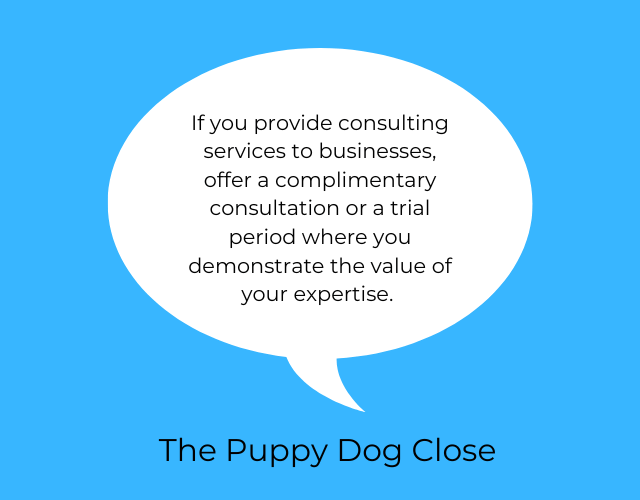
Examples
Software Trial.
If you’re selling software to businesses, offer a free trial period where the company can fully experience the features and benefits of your software. Provide them with access to all the necessary tools and support during the trial. Once they realize how your software streamlines their operations or improves productivity, they’ll be more inclined to become paying customers.
Consulting Services. If you provide consulting services to businesses, offer a complimentary consultation or a trial period where you demonstrate the value of your expertise. During this time, help the client identify and tackle specific challenges they’re facing. By showcasing your skills and delivering tangible results, you’ll build trust and increase the likelihood of securing a long-term consulting engagement.
Marketing Campaigns. If you’re in the business of marketing and advertising, propose a trial run of a targeted marketing campaign to a potential B2B client. Create a mini-campaign that showcases your creativity, strategy, and ability to generate leads or increase brand visibility. Once they see the positive impact and ROI from your trial campaign, they’ll be more inclined to invest in a full-scale marketing partnership.
FAQ
What are the 5 techniques in the closing process?
The five key techniques that often come up in the sales closing process are the Assumptive Close, the Summary Close, the Take Away Close, the Now or Never Close, and the Analytics Close. However, these are just a few of the techniques salespeople can use to close a sale. The most effective salespeople are adept at using a variety of closing techniques based on their prospect’s unique needs and circumstances.
What do you say when closing a sale?
What you say when closing a sale depends on the closing technique you’re using. However, regardless of the technique, it’s important to stay positive, confident, and focused on the prospect’s needs. Use language that reinforces the value of your offering and how it addresses the prospect’s challenges or goals.
What are the 3 forms of closing a deal?
The three primary forms of closing a deal are: the direct close, where you directly ask for the sale; the indirect close, where you use questions or statements to lead the prospect to the decision; and the trial close, where you check the prospect’s readiness to buy before officially closing. Each form can be effective, depending on the situation and the prospect’s preferences.
You’ve made it all the way down here, take the final step

